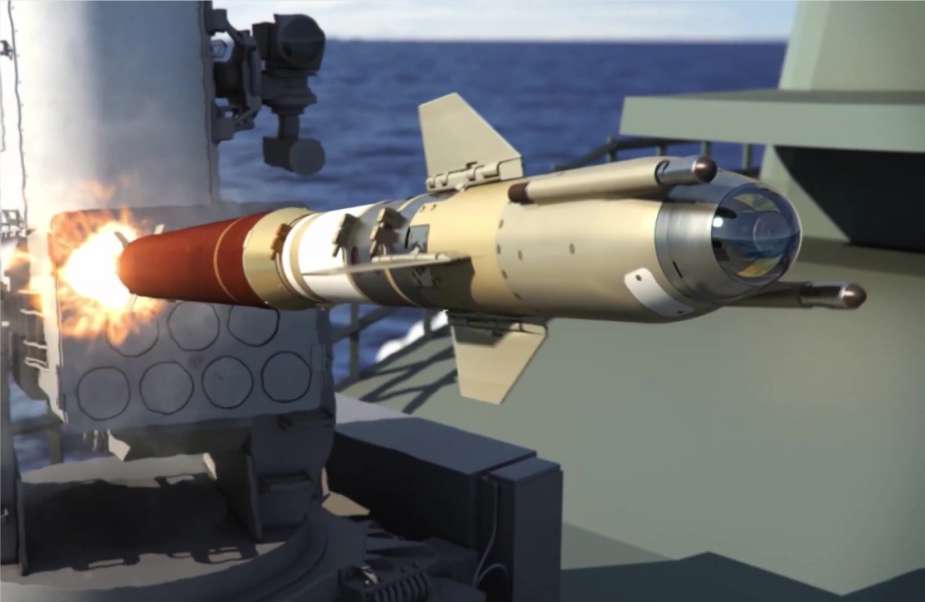Breaking news
US approves $74.6M Foreign Military Sale of RAM Block 2B missiles to Japan.
On October 24, 2023, the US State Department approved a potential Foreign Military Sale (FMS) to the Government of Japan, with an estimated cost of $74.6 million. This approval allows Japan to acquire 63 Rolling Airframe Missiles (RAM) Block 2B tactical missiles, also designated as RIM-116E, along with associated equipment. This includes RAM guided missile round pack Tri-Pack shipping and storage containers, training equipment, operator manuals, and technical documentation.
Follow Navy Recognition on Google News at this link
 The RAM Block 2 missile is integrated into the SeaRAM anti-ship missile defense system, along with the Phalanx CIWS close-in weapon system. (Picture source: Raytheon)
The RAM Block 2 missile is integrated into the SeaRAM anti-ship missile defense system, along with the Phalanx CIWS close-in weapon system. (Picture source: Raytheon)
The package also covers US Government and contractor engineering, technical, and logistical support services, as well as support for the establishment of an Intermediate Level Maintenance Facility (ILMF) and other related logistics and program support elements.
This follows previous FMS transactions where Japan acquired Ram Block 2 missiles, the first in September 2020 for 51 missiles valued at $55.3 million, and a second in August 2021 for 44 missiles, for an estimated cost of $61.5 million.
The RIM-116 Rolling Airframe Missile (RAM) is a small, lightweight, infrared homing surface-to-air missile jointly developed by the United States and the Federal Republic of Germany. The development, production, and maintenance costs are shared among Raytheon and German companies LFK, DBD, and RAMSYS.
The RAM missile was originally intended and used primarily as a point-defense weapon against anti-ship missiles. As its name indicates, the RAM missile rolls as it flies. The missile must roll during flight because the RF tracking system uses a two-antenna interferometer that can measure phase interference of the electromagnetic wave in one plane only. The rolling interferometer permits the antennas to look at all planes of incoming energy. In addition, because the missile rolls, only one pair of steering canards is required.
The RAM guided missile system is deployed on over 165 ships in 11 countries; and its application spans various vessels, from 500-ton fast attack craft to 95,000-ton aircraft carriers. Operating as a supersonic, lightweight, quick-reaction, and fire-and-forget weapon, the RAM system is designed to counter anti-ship missiles. It requires no additional direction post-launch, relying on passive radio frequency and infrared guidance to engage multiple threats simultaneously.
The Block 2 variant of the RAM missile is designed to be more maneuverable with increased intercept range and the ability to counter threats, to enhance the survivability of the defended ship. The RAM Block 2 is equipped with a larger rocket motor, an advanced control section, and an enhanced RF receiver capable of detecting subtle threat emitters.
The launching system for the RAM Block 2 includes the MK 44 guided missile round pack and the MK 49 guided missile launching system, with the MK 31 guided missile weapon system capable of accommodating 21 missiles. This system can be integrated into various US Navy ships, including San Antonio-class amphibious transport dock ships, America-class amphibious assault ships, Whidbey Island-class and Harpers Ferry-class dock landing ships, Freedom-class littoral combat ships, and Nimitz-class aircraft carriers.
Additionally, the RAM Block 2 missile is integrated into the SeaRAM anti-ship missile defense system, replacing the M601A1 Gatling gun in the Phalanx close-in weapon system with an 11-round launcher. The SeaRAM system is present on selected Arleigh Burke-class Aegis destroyers and the Independence-class littoral combat ships.





























